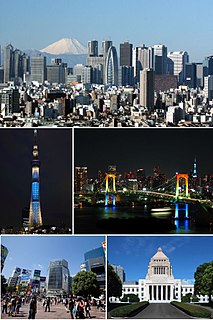Takenaka Corporation is one of the largest architecture, engineering, and construction firms in Japan. Its headquarters is located in Chūō-ku, Osaka, Osaka Prefecture. Takenaka has 8 domestic offices in Japan and overseas offices in Asia, Europe, and the United States.

National Stadium was a multi-purpose stadium in Kasumigaoka, Shinjuku, Tokyo, Japan. The stadium served as the main stadium for the opening and closing ceremonies, as well as being the venue for track and field events at the 1964 Summer Olympics. The Japan national football team's home matches and major football club cup finals were held at the stadium. The stadium's official capacity was 57,363, but the real capacity was only 48,000 seats.
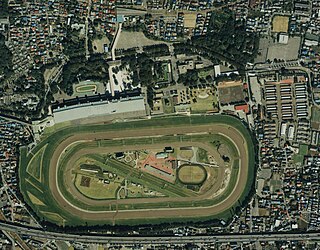
Tokyo Racecourse is located in Fuchu, Tokyo, Japan. Built in 1933 for horse racing, it is considered the "racecourse of racecourses" in Japanese horseracing. It has a capacity of 223,000, with seating for 13,750.
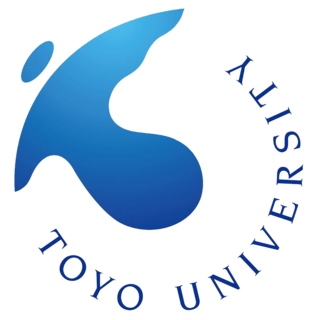
Toyo University is a university with several branches in Japan, including Hakusan, Asaka, Kawagoe, and Itakura.
Tokyo Metropolitan Library is the metropolitan public library system for Tokyo, Japan.
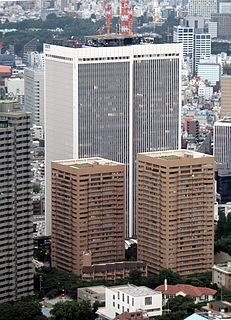
Ark Hills is a major office development by Mori Building Company in Minato, Tokyo. Completed in 1986, the complex includes the ANA InterContinental Tokyo Hotel, the ARK Mori Building, the world-class Suntory Hall concert hall, a TV studio and several apartment buildings. TV Asahi still uses its former headquarters as an annexe for some of its departments and subsidiaries; the network's headquarters themselves were moved nearby building designed by Fumihiko Maki in 2003. Every September the area celebrates with an autumn festival that includes music, dancing, food, art, and shopping.

The Tokyo International Forum is a multi-purpose exhibition center in Tokyo, Japan. The complex is generally considered to be in the Yurakucho business district due to its adjacency to the Yurakucho Station. However, it is administratively in the Marunouchi district.

Sunshine City is a building complex located in East Ikebukuro, Toshima, Tokyo, Japan. It has the 240 metre tall Sunshine 60 skyscraper at its centre. Sunshine City consists of four buildings: Sunshine 60, the main and tallest building, which includes corporate offices as well as restaurants; the Prince Hotel; the World Import Mart; and the Bunka Kaikan building. The complex sits on land that was once occupied by Sugamo Prison.

The Royal Opera House, also known as the Royal Theatre, was an opera house and performing arts venue in Valletta, Malta. It was designed by the English architect Edward Middleton Barry and was erected in 1866. In 1873 its interior was extensively damaged by fire but was eventually restored by 1877. The theatre received a direct hit from aerial bombing in 1942 during World War II. Prior to its destruction, it was one of the most beautiful and iconic buildings in Valletta. After several abandoned plans to rebuild the theatre, the ruins were redesigned by the Italian architect Renzo Piano and in 2013 it once again started functioning as a performance venue, called Pjazza Teatru Rjal.

Water polo at the 1964 Summer Olympics was held at the Yoyogi National Gymnasium in Shibuya, Tokyo. The gymnasium was built in 1961-1964 as the first indoor pool for Olympic water polo; it also hosted all swimming and diving events and could accommodate over 13,000 people.
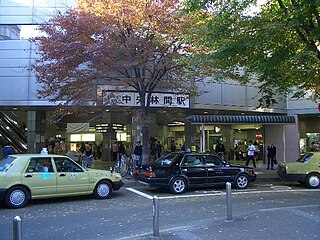
Chūō-Rinkan Station is an interchange railway station in Yamato, Kanagawa, Japan, operated by the private railway operators Tokyu Corporation and Odakyu Electric Railway.

Minami-Senju Station is a railway station in Arakawa, Tokyo, Japan, operated by East Japan Railway Company, Tokyo Metro, and the Metropolitan Intercity Railway Company. The stations for each of these lines are located in separate buildings, necessitating crossing a road to reach each station's ticket exchange.
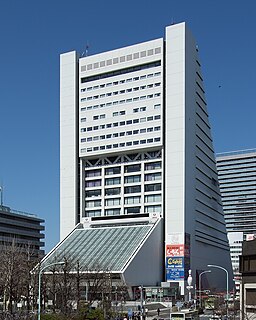
Nakano Sun Plaza is a hotel in Nakano, Tokyo. The hotel includes a concert hall, the Nakano Sun Plaza Hall. Built in 1973, this concert hall seats 2,222 people. The building is to be demolished and replaced by a new complex including a hotel and a concert hall capable of seating 10,000 people around 2024.

The Tokyo Shiodome Building (東京汐留ビルディング) is a building used for offices with a hotel on the top floors at Shiodome in Minato, Tokyo, Japan. It has a height of 174 metres with 37 floors. The building was constructed from 2002 to 2005 and is owned by Mori Trust and Sumitomo Real Estate.

The Tokyo Metropolitan Police Department serves as the police force of Tokyo Metropolis. Founded in 1874, it is headed by a Superintendent-General, who is appointed by the National Public Safety Commission, and approved by the Prime Minister.
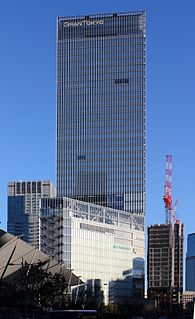
The GranTokyo is a skyscraper located in Marunouchi, Tokyo, Japan. Construction of the 205-metre tower was finished in 2007. The first fourteen floors of the building are occupied by a Daimaru department store.
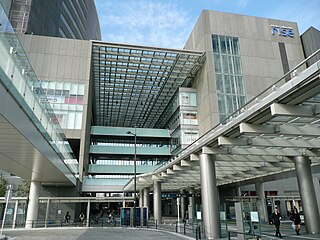
The Futako-Tamagawa Rise (二子玉川ライズ) complex comprises an upscale retail shopping series, high-rise apartment towers, and cultural space near the Futako-Tamagawa Station/transportation hub. Located to the east of the FT station on the Tama River marking the southern metropolitan boundary of Tokyo, Futako-Tamagawa is the second major crossing upstream from the mouth of where the Tama River empties into Tokyo Bay. This immediate area was the location of the first then-"suburban" location of Takashimaya in the 1970s. It has had continued growth, development, and even strategic-level planning since its launching of a garden city project since the 1920s launching. It is near the Den-en-chōfu upscale residential area. Futako-Tamagawa Rise currently has two of its three development projects complete, including 151m tall towers, making them among the top 150 tallest buildings in Tokyo. Futako-Tamagawa, meanwhile, is listed in travel literature as being "core" or "central" Tokyo.
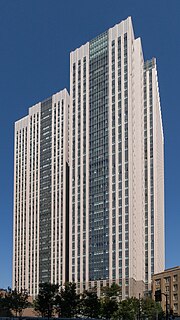
The Kasumigaseki Common Gate is twin tower buildings located in Kasumigaseki, Chiyoda, Tokyo. The buildings consist of East Tower and West Tower. Together with the adjacent Kasumigaseki Building, the first modern office skyscraper in Japan, the twin towers are landmarks in the Toranomon/Kasumigaseki area. The buildings are directly connected to Toranomon Station of Tokyo Metro Ginza Line.

Tokyo Garden Terrace is a 227,200-square-meter mixed-use development in Chiyoda, Tokyo, Japan. Completed in 2016, it includes office, residential, commercial, hotel, and leisure space.

